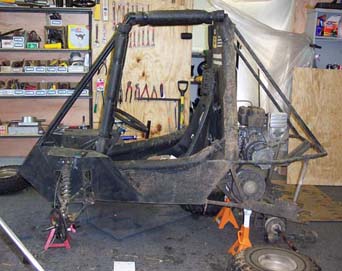
|

 Mini-BAJA car four wheel steering system in the construction phase.
Mini-BAJA car four wheel steering system in the construction phase.
The objectives set forth by the project sponsors, Dr. Patrick Hollis and FSU SAE president Patrick Middleton, was to reduce the turning radius of the car by means of a four wheel steering system and to accomplish the production of this system for $500 or less.
It was determined that a turning radius of less than 7’ would be required to efficiently navigate the most extreme turns during the Mini-Baja competition. The previous Baja car was found to have a turning radius of 14’ making it difficult to navigate the course. The goal for this design was to greatly reduce this radius to under 7’ if possible.

The second most important aspect of our design was that it be strong enough to withstand the punishment of an off-road vehicle course. These courses are typically strewn with obstacles such as logs, stumps and small drops which could possibly break lesser steering systems. In fact the system that the new design will replace has had many failures specifically at the tie rod ends. A failure of this kind during competition would result in a drastic drop in the standings. Having confidence that the system will withstand all but the most extreme forces should allow the driver to take chances that normally would be out of the question with weaker systems.
As with any car there is a limited amount of space available to install and mount components. The Baja car does not have an extraordinary amount of space available, so the size of the system had to be carefully scrutinized. There had to be clearance for the wheels to turn, the rack to travel and for the shafts to rotate freely. It was determined that in order to allow the rear wheels to travel 15 degrees the rear end of the car must be widened. A U-joint was chosen to give the rear shaft clearance over the swing arm but still allow it to rotate freely. Rear rack mounting was also a concern. There is not sufficient room to mount the rack in front of the rear axle so it must be mounted behind it, making it vulnerable to obstacles the driver may encounter. Additionally, the weight of the system was a concern as any extra weight can greatly hinder the performance of a vehicle. An effort will be made to reduce the weight of the components and materials used for the system.
Perhaps the most important factor that cannot be quantified is the comfort of the driver. When implementing a four-wheel steering system the “feel” of the car changes. With a front wheel steering system the car turns about the back wheels but a four wheel steering car will turn about some point between the front and rear wheels. One of the problems faced was trying to retain a “normal” feel but still achieving the desired turning radius. Another concern was the stability of the car during turns. Although the driver would be expected to slow down to take a sharp turn it must be predicted that at some time a sharp turn will be made at a high speed. For this reason the stability of the car was scrutinized, a fact reflected in the final design.
Website comments or suggestions: email the webmaster
|









